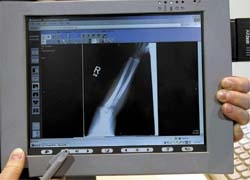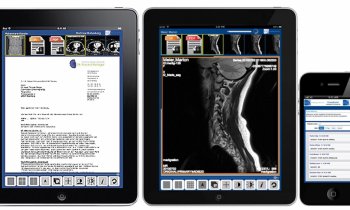Mobile PC
Chemnitz Hospital gGmbH, near Hanover, covers almost all medical disciplines and, with 1,855 beds and a 3,000-strong staff, this is one of the biggest in Germany. Recently the hospital, comprised of 22 clinics, eight institutes and other multidisciplinary departments, has undergone extensive renovation and construction work, with modernisation including information technology (IT) systems
Since November last year, the Pen Tablet PC 3500, with MagicWeb/ Acom.web image distribution software, was field tested there by Dr Martin Herbst,

who used the portable PC (weight: about 3 lbs. Thickness: under one inch. Dimension: 8 1/2 inches) during paediatric surgery ward rounds. He reported that it reduced time spent by up to 30 minutes, and eliminated some later work because he did not have to examine X-ray and report images on the PC after each round. Input of new data into the RIS/PACS system takes place at the bedside.
Made by Fujitsu Siemens Computers (FSC), the mobile electronic patient folder is part of the Sienet Version 40 integrated radiology suite. The PC’s wireless LAN infrastructure allows mobile access across a ward to the server containing patients’ folders plus corresponding data and X-ray images.
Instead of using a keyboard and mouse, a special pen is used on the mobile PC’s screen. Much like a notebook, the PC uses an infrared keyboard. Also, when connected to a docking station, it provides full desktop functions.
During the field test, roaming, i.e. changing from the signal range of one access point to the range of another, functioned perfectly. Patient data security is guaranteed by the Sienet mobility concept, says the manufacturer.
Following the successful field test of the Tablet PC, they now will be used in all the hospital’s wards, said Dr Olaf Schlimpert, Head of Medical Information Technology at the hospital, who added: ‘My goal is to install a wireless LAN infrastructure throughout the Chemnitz Hospital.’
Voice recognition Kaiser Franz Josef Hospital, Vienna, is using Siemens’ Sienet 40, an integrated voice recognition radiology system. The hospital’s personnel say reporting time has thus been reduced from 10.5 to 6.5 hours, a 38% drop.
The hospital’s objective was to integrate RIS and PACS into a single database, and a voice recognition system was to be implemented to allow for rapid changes in users and individual identification.
Following the upgrade, each workstation at the Kaiser Franz Josef Hospital can access information on parallel patient examinations as well as create integrated reports, for same day relay. An additional advantage is that urgent reports can be created when administration teams are not available, e.g. during night shifts.
30.04.2003










